(Upload on October 26 2025) [ 日本語 | English ]
Mount Usu / Sarobetsu post-mined peatland
From left: Crater basin in 1986 and 2006. Cottongrass / Daylily
HOME > Lecture catalog / Research summary > Glossary > Succession
|
Def. Changes in communities with time
translated as sen-i (遷移) in Japanese  Pioneer (先駆種): earlier successional species tending to be sun tree and/or generalist Climax species (極相種)tending to be shade tree and/or specialist |
The mechanisms of succession explained by Grime's triangle (グライムの三角形による遷移機構の説明)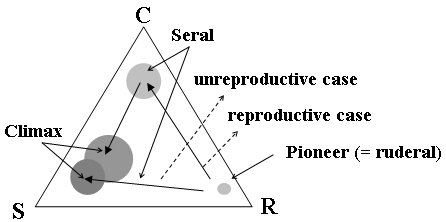 Fig. successional trajectories explained by Grime's triangle. Initial condition of productivity is important for those trajectories. |
| Holistic | Reductionistic |
|
Ecosystem Emergent properties Autogenic changes - facilitate succession Orderly, predictable, deterministic |
Individuals, or species Autogenic changes inhibit succession Stochastic The sequential physiognomic dominance of the site by species with different life histories, growth rates, and size at maturity |
|
Clements (1916)
Monoclimax theory - climatic climax
Autogenic succession |
Gleason (1926): Individualistic concept of vegetation Whittaker (1953): Climax pattern theory Egler (1954): Relay floristic composition Drury and Nisbet (1973) Initial floristic (mainly old field) Connel and Slatyer (1977)
Rejected facilitation (reaction) |
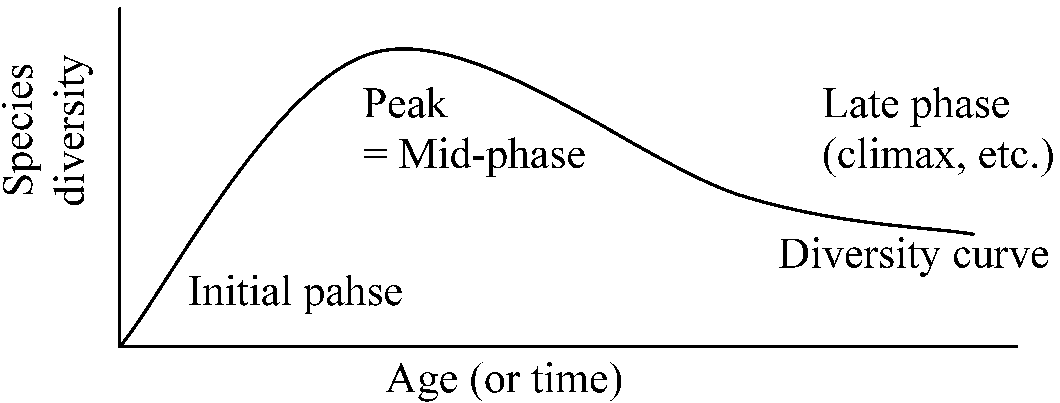 Changes in species diversity across succession (Drury & Nisbet 1973) |
Primary succession (一次遷移)Xeric succession (乾性遷移)Case: volcanic succession (火山遷移), e.g., on Mount Usu and Mount St. Helens (セントへレンズ山)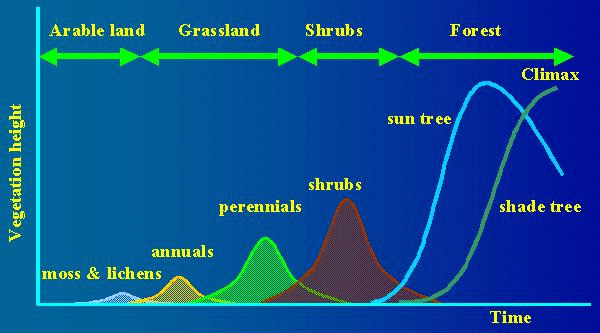 Representative of primary, xeric succession (Whittaker 1975). Vegetation becomes tall with increasing time. Mesic succession (湿性遷移) Fig. Inundated or saturated so as to support or preduce of vegetation typically adapted to like in saturated soil. |
Secondary succession (二次遷移)Secondary succession: started by disturbances that do not completely remove the former preexisting vegetation and soil
Post-mined peatland
landscape of skislope |
In the early stages 1 1
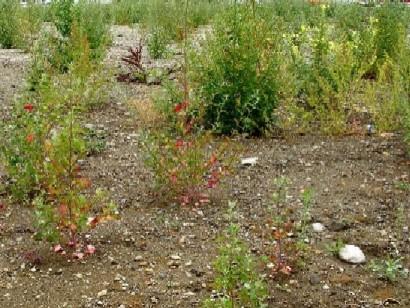 2 2
[1/2] The landscape is one year after a bare land was created due to closing a pachinko parlors. The dominant species were Chenopodium album, Oenothera biennis and other annuals. The vegetation recovery is greatly determined by seedbank. On N24/E1, Sapporo City, on August 30 2008. 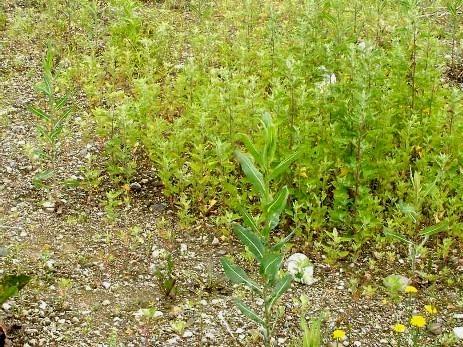 3 3
 4 4
[3/4] These are the landscape of two years after the creation of bare land. Species composition changed greatly to Lactuca scariola (annual to biennial). [3] A perennial Artemisia montana patch developed. [4] Brown stalks are Rumex obtusifolius (perennial). On July 30 2009. |
Secondary vegetation (二次植生): vegetation that develops after disturbances (s.l.)
secondary vegetation made by human activities (代償植生) (s.s.), e.g., agricultural lands, artificial forests and satoyama Secondary forest or second-growth forest (二次林): forests out of secondary vegetation types↔ old-growth, primary or primeval forest |
Three factors on climax
 Fig. 6. Soil structure and successional trajectories of plant associations in active and stabilized dunes across seven geomorphic zones (Soromotin et al. 2024) |
Climax species (極相種): a plant species dominating the final stage of succession, known as the climax community General key characteristics: shade-tolerant, slow-growing but long-lived, K-strategy, poor colonizers and stable dominance Climax community or vegetation (極相群集): the final, stable stage in the process of successionClimax forest (極相林): the final stage of succession dominated by tree species General key characteristics: ecological stability, dominance of climax tree species, high biodiversity, minimal disturbance and dynamic equilibrium (gap dynamics) |
|
Type I. Successional pace calculated along a temporal flow 1) Sørensen's community coefficient (遷移群落類似度指数), CC (Bornkamm 1981, Tsuyuzaki 1991)
CC = 2a/(2a + b + c)
PS = 2Σmin(xi, yi)/Σ(xi + yi) × 100 3) Speed of succession, D (遷移速度)
species
t1
t2
t2 - t1
square
D = Σi=1s[n(x, y, t2) – n(x, y, t1)]2
Vi = maxj=1n(|Pij – P(i–1)j|) |
Type II. Succession degree calculated by vegetation structure 1) Degree of succession (遷移度), DS (Numata 1969)
DS = (Σi=1nlidi)/n × v
SI = cΣi=1n(di·l) |
|
The sequential set of changes in structure and composition of (plant) communities. In Japanese, there has not been any nice translation on chronosequence. The phonological translation is often used. Here, I indicate a tentative translation. ExamplesPlant communities on post-fire forest, glacier retreat, lava, skislopeAll ages on the researched sites should be determined.
|
Ex. Sakurajima Island, Kyushu, Japan (Tagawa 1964) Problems on the assumption of chronosequence
|
[facilitation on Mount Koma]
Facilitation vs competitionDef. Facilitation: a type of positive interaction where one species enhances the survival, growth or reproduction of another or othersCompanion plants (コンパニオンプランツ): plants that are grown together because they benefit each other in some way, through pest control, improved growth, pollination support or soil enhancement = commensal plant (共卓植物) Stress gradient hypothesis, SGH (ストレス勾配仮説)
(Maestre et al. 2009) Revised SGHLife history of interacting species
competitive
resource (e.g., nutrients) |
(Successional) facilitationIn which the influence of early species in a community succession is to facilitate establishment of later ones by changing the conditions encountered. (Begon et al. 1996)
Fig. Temporal changes in facilitation, competition and tolerance along successional sere Types of facilitationDirectA. Ameliorate harsh environmental conditions = Resource modification
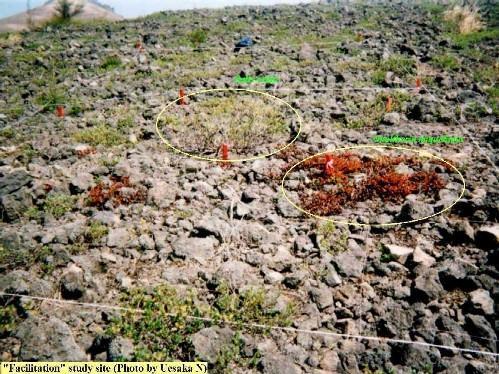 Fig. 2 Study site to evaluate the effects of two patch-forming shrub species, Salix reinii and Gaultheria miqueliana, on cohabitants on Mount Koma (photo by S. Uesaka). (Uesaka & Tsuyuzaki 2004). A deciduous shrub, S. reinii is likely to be facilitative, and an evergreen shrub, G. miqueliana seems to be inhibitive. The patches increase moisture and nutrients in the volcanic deposits, and decrease solar radiation on the ground surface. Tussocks (谷地坊主) in wetlands often have facilitative effects (Koyama & Tsuyuzaki 2010).
Fig. 2 Study site to evaluate the effects of two patch-forming shrub species, Salix reinii and Gaultheria miqueliana, on cohabitants on Mount Koma (photo by S. Uesaka). (Uesaka & Tsuyuzaki 2004). A deciduous shrub, S. reinii is likely to be facilitative, and an evergreen shrub, G. miqueliana seems to be inhibitive. The patches increase moisture and nutrients in the volcanic deposits, and decrease solar radiation on the ground surface. Tussocks (谷地坊主) in wetlands often have facilitative effects (Koyama & Tsuyuzaki 2010).
B. Alter the characteristics of soil substrates
C. Epiphytes (e.g., orchids, ferns, mosses, algae)
Indirect
|
|
Quiz
|